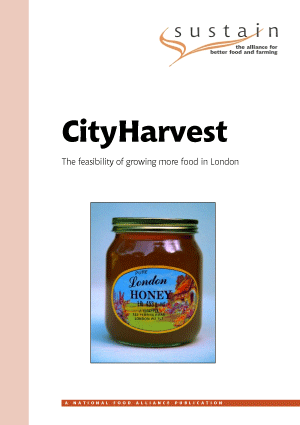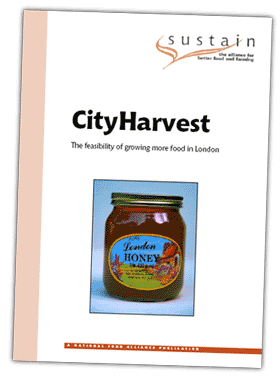
City Harvest: The feasibility of growing more food in London
ISBN: 1 903060 01 X - 176pp - 1999 | 1982Kb

City Harvest: The feasibility of growing more food in London
ISBN: 1 903060 01 X - 176pp - 1999 | 1982Kb
 This report looks at the feasibility of food production in cities. It takes London as its example, but is relevant to all urban areas.
This report looks at the feasibility of food production in cities. It takes London as its example, but is relevant to all urban areas.
This report forms part of the City Harvest project, an initiative managed by Sustain: The alliance for better food and farming. Since 1997 City Harvest has worked to promote, develop and research the potential for food growing activities in London as a means of contributing to its social, economic and environmental regeneration.
The 176-page publication covers urban food systems and an overview of existing food growing activities. With inspiring examples and case studies from the UK and abroad, the report presents a conclusion and detailed recommendations, and includes maps, a glossary, and sources of more information.
"London could become a pioneer of urban agriculture for the UK, and even for Europe. The breadth and depth of expertise in the capital is impressive and, with a supportive policy framework, could significantly improve the quality of urban living."
Progress update
Since this City Harvest report, and the earlier Growing Food in Cities publication, Sustain and London Food Link have launched the Capital Growth campaign, aiming to support the creation of 2,012 new community food growing spaces for London by the end of 2012. In addition, Sustain launched in 2012 the Big Dig campaign to promote volunteering and community food growing in seven cities around the UK. We have also supported community food growers through the Making Local Food Work and Ethical Eats programmes to take an enterprising approach to growing and selling urban food, with publications such as:
Report contents
Summary
1) London: An introduction
2) Urban agriculture
3) The environment
4) Economic development
5) Health
Case studies
Map
‘Bringing it all together’
6) Community development
7) Education and training
8) Sustainable land use
9) How much could London produce?
10) Conclusion
Appendices
London Food Link: London Food Link brings together community food enterprises and projects that are working to make good food accessible to everyone in London to help create a healthy, sustainable and ethical food system for all.
Sustain
The Green House
244-254 Cambridge Heath Road
London E2 9DA
020 3559 6777
sustain@sustainweb.org
Sustain advocates food and agriculture policies and practices that enhance the health and welfare of people and animals, improve the working and living environment, promote equity and enrich society and culture.
© Sustain 2024
Registered charity (no. 1018643)
Data privacy & cookies